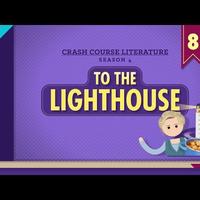To the Lighthouse: Crash Course Literature 408 - YouTube
Hi, I'm John Green, this is Crash Course Literature,
and today we're letting Virginia Woolf take us to the lighthouse.
Well, assuming the weather holds and we don't get lost in our
endless spiraling contemplation of the ephemerality of all human life.
We're gonna explore 'To the Lighthouse' as a modernist novel, examine its form
and style, and discuss its philosophy
and also its thrilling plot, so get that rowboat ready!
[intro sequence]
So Virginia Stephen was born in 1882 to Julia Jackson Duckworth - a member of a publishing family,
and Leslie Stephen - a literary critic and the founder of the Dictionary of National Biography.
They were English, if you can't tell from their names and the idea of a Dictionary of National Biography.
Both of her parents had been married before, Virginia had three full siblings and four half siblings
and her most treasured childhood memories were of holidays spent in Cornwall.
Conveniently, near a lighthouse.
In 1904, she and her sister Vanessa moved into a house in Bloomsbury, London
and became the center of a social circle of artists and writers and thinkers known as The Bloomsbury Groups
Stephen began to write for the Times' literary supplement and in 1912,
she married the political theorist Leonard Woolf. In 1915, Virginia Woolf published her first novel.
She also struggled with mental illness throughout most of her life, even as she became an acclaimed writer
of fiction and nonfiction and during the Second World War,
she loaded her pockets with stones and walked into a river, drowning herself.
Okay, so that's a bit about the author.
Before we explore the form and themes of To the Lighthouse,
let's review the plot.
The Ramsay family and a few friends spend a day at their vacation home. They talk about going to the
lighthouse, but don't. Ten years pass, and then they do go to the lighthouse.
Then the book is over.
No need to go to the the Thought Bubble for that plot. But even though not much happens,
a lot is happening in To the Lighthouse.
So this is a modernist novel
Broadly speaking, modernism was a philosophical and cultural movement
That got going in the late nineteenth century and reached its apex just after World War I
With forty one million people dead on the WWI battlefield
It was hard to go back to the same old
pictures and tunes.

